Your Guide to May's Best Veggies
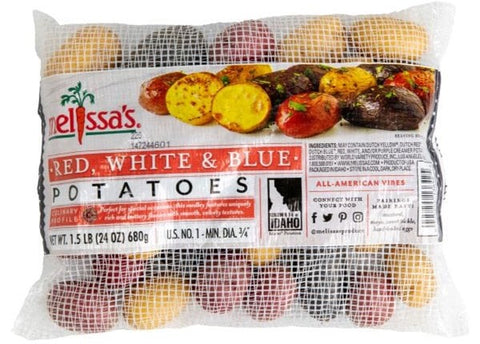
May is the first month of the calendar for outdoor activities, gatherings and events, usually followed by food—lots of food for lots of hungry people. Melissa’s Red, White, and Blue potatoes can help satisfy those tummies by bringing seasonal color and fun to the table. Melissa’s Red White and Blue Potatoes are a nice mix of our signature Dutch Potato varieties: Dutch Yellow®, Dutch Red® (formerly Crimson and Gold®), and our new Dutch Blue® Potatoes.
Based on marketing research, our signature Dutch Potato is the most popular 24 oz. potato sold in the United States! Perhaps it is for their ease of preparation, size, and most of all, flavor. Grown in Magic Valley, Idaho, where volcanic soil easily drains to yield potatoes with tender skin and no divots from rocky soil. Best of all, this variety of potato neither requires peeling nor greens on the skin!
Melissa’s Red, White, and Blue Potatoes can be prepared in any method you choose- steam, boil, or roast- for breakfast hash or breakfast burritos, your family’s secret potato salad recipe, kabobs, potato pizza crust, vegan buffalo meatballs, or even add to your grazing board dippers! Melissa’s Red White and Blue Dutch Potatoes are a must have for your spring and summer meals, and are available separately throughout the year for soups, stews, and family roasts.
Store potatoes at room temperature in a dry area away from moisture and onions. Do not store in the refrigerator where the starch in potatoes will turn to sugar.
Simply rinse potatoes in a colander, pat dry, then prepare as you wish. We do not recommend freezing raw or cooked potatoes.
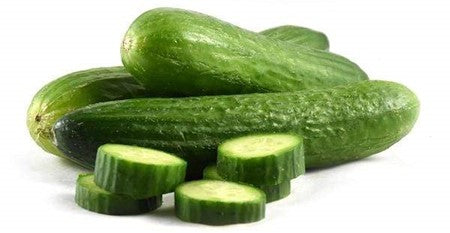
Also known as Persian Cucumbers, Melissa’s Mini Cucumbers have a hint of lemon profile, are refreshingly crisp, virtually seedless and firm, with edible skin and oh so easy to include in just about any dish! Did we mention they are also a variety of ‘burpless’ cucumber? Each cucumber is just the right size for snacking or dipping in a little Costa Azul Hot Sauce, stuffed with seafood or cream cheese and herbs, stacked in a sammie, or included in ceviche, fresh tomato or Asian cucumber salads, and grazing boards. Even cool cucumber soup! Cucumbers, due to their high-water content, are known as a ‘cooling’ ingredient for one’s body, helping to calm as well as purge toxins from the body. Sliced and placed upon closed eyes or over cuts, they can help reduce swelling and discomfort.
When selecting Melissa’s Mini Cucumbers, look for rigid ends and firm fruit (yes, it has seeds, botanically qualifying as a fruit) absent of shriveling or discoloration. Refrigerate unwashed and uncut for up to one week wrapped in a paper towel and plastic bag or in a crisper drawer. As cucumbers are mostly water, freezing for future use is not recommended.
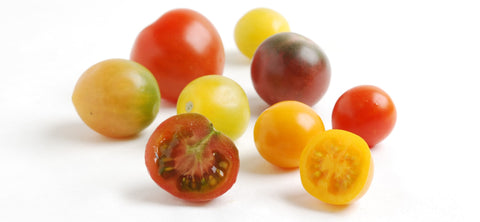
So colorful, they look like candy!!! Not to mention, Melissa’s Baby Heirloom Tomatoes are also juicy and sweet. Their smaller size makes them very pop-able for snacking, adding to caprese kabobs or grazing fruit kabobs, and summer picnics, but also tasty and a great color addition to ubiquitous green salads. As heirloom tomatoes generally have a sweeter profile, try them lightly oiled and roasted to amp up sides and noshes.
What makes a produce item ‘heirloom’? In general terms, heirloom produce is grown from seeds or rootstock passed down through generations and are open pollinated, not hybridized. This is why you see such a variety of colors, shapes, and sizes. They are not grown for disease resistance, but rather, for flavor!
When selecting tomatoes, check for any shriveled, split, or soft fruit. Tomatoes hold their flavor best when stored at room temperature away from heat. Refrigeration causes tomatoes to lose flavor and texture.
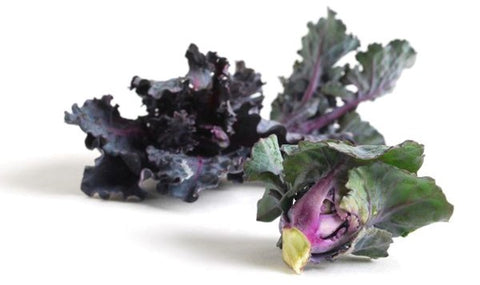
Toothsome, cute, and flavorful, Melissa’s Kale Sprouts are a hybrid of Red Russian Kale and Brussels Sprouts. Their striking purple, magenta, and forest green leaves are fabulous raw or sautéed, roasted or grilled. Kale Sprouts add color and crunch to slaws or sides, and roasted roots or summer veggies. A bit peppery in flavor, this cruciferous veggie can be tamed with a little lemon, citrus, or vinegar. Put them in a grill pan with a light coating of oil and char them, then blend with a drizzle of balsamic and toss in some pine nuts. YUMMERS!
Select Kale Sprouts that have no withered leaves, dark spots, or discoloration. Prepare Kale Sprouts the same as Brussels Sprouts- wash well, drain, and pat dry. Trim the bottoms just enough to keep all layers intact, then halve head to toe and proceed as your recipe instructs. Raw Kale Sprouts should be kept unwashed in a plastic bag and refrigerated until preparation, up to two weeks. Kale Sprouts do not freeze well unless cooked and included in a casserole, gratin, or soup.
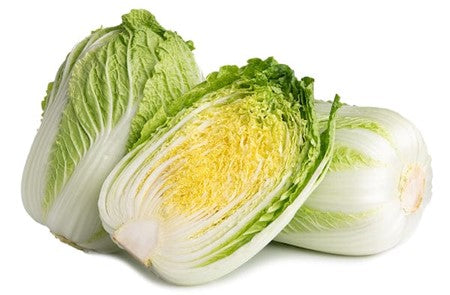
So much of our ‘American’ cuisine is really a fusion of the myriad of ingredients from all the cultures that make up America. Asian Napa Cabbage, also known as barrel cabbage, is one of those ingredients. Napa is a crucifer milder in flavor and less bitter than the common green cabbage, with delicately crinkled leaves and satisfyingly crisp, flat ribs. A vital ingredient in kimchi and Chinese Chicken Salad, many chefs and home cooks have found Napa Cabbage to be delicious as a lettuce wrap, and a quick cooking addition to soups. Double up the leaves for a more tender cabbage roll, or braise with bacon or ham and a dash of red wine vinegar to pair with pork or chicken.
Select Napa Cabbage that has fresh, not wilted leaves, firm ribs, and no spots or discoloration. Refrigerate in a plastic bag and store in the crisper up to 2 weeks.
Due to its high-water content, Napa cabbage will not freeze well.
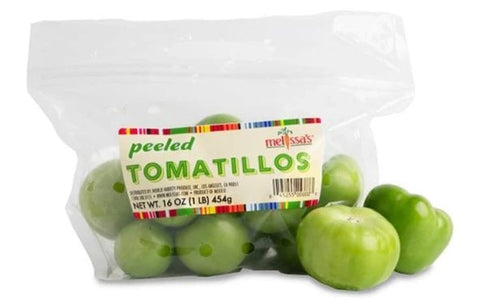
If you’re a person who likes tangy, sweet-sour ingredients that perk up one’s palate, then Melissa’s Peeled Tomatillos should be on your radar. Tomatillos, a member of the nightshade family and sister to tomatoes and goldenberries, have a tangy profile as well as natural pectin which acts as a thickening agent. Grown on a vine and harvested with their capes, the thin papery husks that protect the fruit (botanically) but can be bothersome to remove for cooking preparation as they tend to stick to the pretty green skin. Melissa’s has solved the problem for you by offering Peeled Tomatillos in a clear tote bag, another plus for easy selection. No more peeling and sorting at the tomatillo display! Simply rinse off the tomatillos, pat dry, and include in your favorite salsa, enchilada sauce, ceviche, or homemade relish! Tomatillos may be served raw or cooked. In their raw form, the fruit will be tangy and crisp in a salsa cruda in place of its cousin, the green tomato. Charred on the grill or in an oven yields the additional smoky depth of flavor so often found in Southwestern salsa and chili verde. Add them whole or halved in a soup to add flavor and to thicken the broth. But beware, regardless of how they are used, the pectin will thicken the viscosity of your dish. To remedy, simply add more broth or liquid of choice!
Select firm fruit with no dark or soft spots. Fresh Tomatillos are best kept in a paper bag and refrigerated up to two weeks until washed and prepared. Once prepared, refrigerate, and consume within the week. Tomatillos may be frozen. Once husk is removed and fruit is washed and dried, place single layered on a sheet pan and freeze. Once firm, transfer to a labeled freezer-proof bag. Use in sauces, soups, etc., as the fruit will no longer have firm texture.
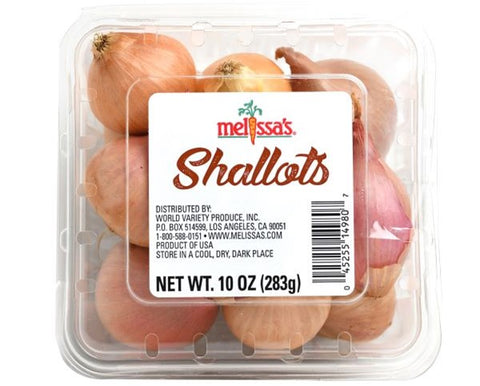
SHAL-lots or Shal-LOTs. No matter how you say the word, this aromatic allium is a must have as many chefs have discovered. Alliums are not onions. Alliums grow as a clump of multiple bulbs or cloves, just like garlic. Whereas onions grow as a single bulb.
Most commonly seen deep fried, adding a crunchy garnish to gratins, casseroles, salads, and creamy dips, shallots are also the secret ingredient in many dressings, creamy soups, and relishes. Since shallots are sweeter, they are a less pungent substitute for onions. They are also fabulous as a braised side dish or addition to an antipasto platter. Keeping the shallot’s root end intact, wash, peel and halve, then roast until tender. Dress with balsamic, butter, a pinch of salt and fresh thyme.
Select shallots that are firm and dry with no sprouting, soft spots or mold. Store up to one month in a dry, room temperature area away from tomatoes and potatoes. Shallots may be frozen if cooked and included in a casserole or soup. Melissa’s Shallots are available organic or conventionally grown in USA.
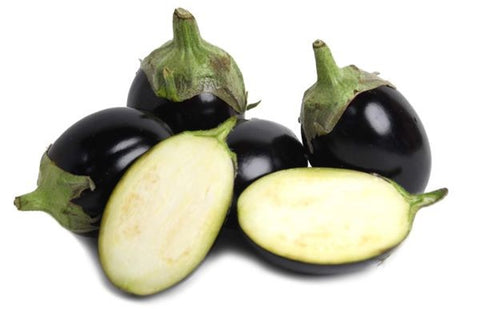
Grilling season is upon us! Time for veggies of all shapes, sizes, colors, and textures. Enter Melissa’s Indian Eggplant, cute little orbs with shiny purple skin and creamy flesh. Eggplant, a member of the nightshade family and named for its shape, must be grilled, fried, braised or steamed before consumption. Indian Eggplant may resemble the popular Italian eggplant, but is smaller in size with a creamier, sweeter flesh; less prep and easier to serve! Simply wash, pat dry, halve from stem to base and salt the flesh to purge any water and bitterness. Allow to sit about 20 minutes, then rinse and pat dry. Lightly brush with oil, season and grill until the center is tender. Serve with other grilled veggies, add to green salads, or as a side.
Select Indian Eggplant with shiny, taut skin and green calyces. Avoid brown or soft spots, cracks or wrinkles. Refrigerate whole, unwashed eggplant in loose paper towel and plastic bag 4-5 days. Eggplant does not freeze well whether raw or cooked.
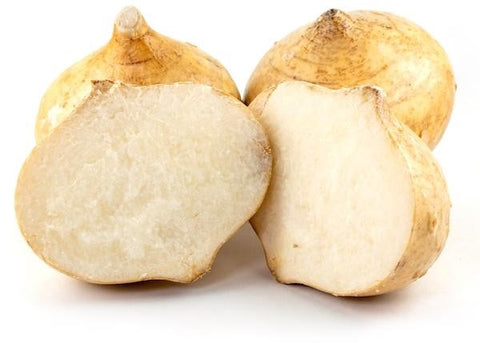
Jicama may look like a giant chestnut but is actually a root vegetable indigenous to Central America and Mexico, then introduced to Asia via Spanish trade. Jicama may be served raw and crispy, or cooked yielding a firm texture, thus a more accessible substitute for hard-to-source fresh water chestnuts. Melissa’s Jicama is sold with or without wax coating to protect the skin from abrasion and mold. Due to its high water and fiber content, sliced jicama makes a great low calorie, nutritious snack! Just add a squeeze of Melissa’s Key Lime and a dash of Melissa’s Pico de Gallo over peeled and sliced jicama.
Jicama pairs well with fruits and vegetables, making it versatile for grazing and nosh boards, stir fries, roasted jicama fries, grated or julienned salads, spring rolls or wontons. It is also tasty and refreshing in citrus and tropical fruit salads.
Select jicama heavy for its size, avoiding cracks or shriveling. Store whole, uncut jicama in a cool area up to two weeks. Once washed and peeled, wrap in plastic wrap and refrigerate up to one week.
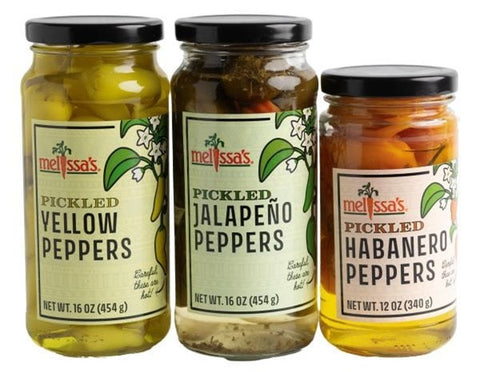
Everyone likes to have condiments with their meals, especially during the outdoor Spring and Summer months. They can add color, extra flavor, crunch and satiety.
Melissa’s Pickled Peppers fit the bill, with their vinegary tang and heat to stimulate your palate to enjoy your meal. Besides, they’re cute to look at, too! Add them as a complement to picnics, barbecues, or chop into salads. Melissa’s Yellow Peppers, a small one-bite pepper, have a mild heat and vinegary zing. Moving up the heat scale are Melissa’s Pickled Jalapeño Peppers. You know, the ones talked about in jumping rope games? Pickled with carrots and onions, they add color to crudité platters and zip to sandwiches. Try the brine in coleslaws and potato salads! And if you still need more heat, then go for our Pickled Orange Habanero Peppers, considered thirty to fifty times hotter than jalapeños!

